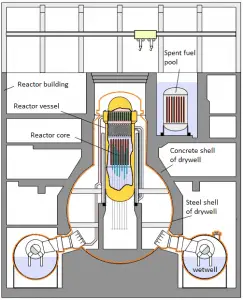Drywell and Wetwell in BWR Containments
BWR containment buildings. Modern boiling water reactors (BWRs) have no steam generators so that the reactor coolant system is more compact than that of pressurized water reactors (PWRs). The containment building can be correspondingly smaller. On the other hand, BWRs also utilize the large heat sink inside the containment building for energy removal during reactor isolation events. This is because slightly radioactive steam forms excess energy, which cannot be released into the atmosphere. The BWR containments vary widely depending on certain reactor designs. The major containment designs are Mark I, Mark II, and Mark III. The BWR containments usually consist of the following parts:
- Drywell. A drywell houses the reactor coolant system.
- Suppression pool or wetwell. A wetwell is a suppression chamber, which stores a large body of water, and therefore it is commonly called the suppression pool.
- Containment envelope. The Mark III containment leaks a tight, cylindrical steel containment vessel. This vessel surrounds the drywell and the suppression pool.
The purpose of the drywell and the wetwell (suppression pool) is to reduce the pressure if a LOCA or a MSLB occurs. The steam from a leak in these cases enters the drywell and is directed through submerged tubes into the water of the suppression pool (wetwell), where it condenses, and the pressure in the drywell is reduced.
